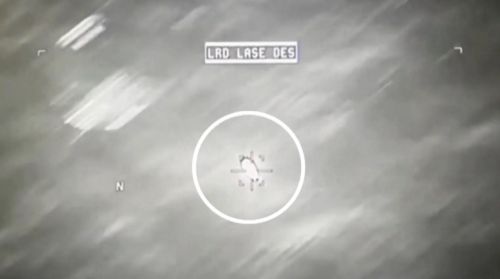

Even if the orb proves to be adversary tech, sensor artifact, or a glancing engagement, the case highlights a real problem. Our public conversation has to handle ambiguity without filling it with fantasy.

By Matthew A. McIntosh
Public Historian
Brewminate
Introduction
On September 9–10, members of Congress were shown video of a U.S. MQ-9 Reaper tracking a bright orb off Yemen in October 2024. A Hellfire missile appears to strike the object and then continue past it, as if glancing off. Several outlets published the clip and reactions from lawmakers and former officials, while the Pentagon declined substantive comment. The footage is real in the sense that Congress viewed it. Its meaning is not settled.
What the Video Appears to Show
The sequence, presented by Rep. Eric Burlison, shows a glowing sphere above the water. A missile streaks into frame. On slowed playback the warhead seems to contact the orb, and then the streak continues as if it kept going, while the object persists and pieces that appear to detach from it continue in motion with it. Coverage with the on-air clips and stills comes from CBS News; the hearing segment also circulated on and broadcast socials. The date cited for the original sortie is October 30, 2024, and the launch platform was a U.S. Reaper.
What We Actually Know, and What We Do Not
We know the imagery exists, the House panel viewed it, and that it was presented as a Yemen-area incident recorded by U.S. platforms. We also know that Pentagon officials offered no detailed explanation, and that the All-domain Anomaly Resolution Office (AARO) has stated more broadly that it has found no verifiable evidence of extraterrestrial activity from anecdotal military reports. We do not know the mission context, the exact missile variant, the fuze settings, the engagement geometry, or whether other sensor angles exist that would alter the impression of a direct hit.
A recent government tally cited at the hearing noted more than 750 new UAP reports between May 2023 and June 2024, which explains some of the congressional pressure for declassification, while also reminding us that “unidentified” describes our state of knowledge, not the origin of any single object.
Why the “Bounce” Could Be Real, Apparent, or Something in Between
A Hellfire is a family, not a single weapon. Variants include high-explosive and shaped-charge warheads as well as the R9X “ninja” version that kills by kinetic impact rather than an explosive blast. Depending on the model, fuze logic, approach angle, and whether the seeker had terminal guidance, a graze or glancing contact could produce a track that looks like a pass-through on a single sensor. None of that proves what the orb is. It only shows that conventional explanations remain available and must be considered before extraordinary ones.
Single-sensor perspective also matters. A narrow-field electro-optical or IR view can compress depth and make near-misses look like hits. If the target sits above water, a detonation or splash just out of frame can read as “nothing happened” even if the warhead functioned. Without multi-angle telemetry and the weapon system’s own engagement logs, the clip alone cannot adjudicate which interpretation is correct. That is a limitation of the medium, not a verdict on the mystery.
The Extraordinary Hypothesis
Could it be a technology outside known performance envelopes, including non-human origin. That is logically possible. It is not supported or refuted by this video alone. In public remarks, witnesses said no known U.S. system could “split” a Hellfire and remain intact. That is a fair on-record opinion, not a proof about the object. The appropriate posture is disciplined humility: keep possibilities on the table (even those of extraterrestrial origin unless demonstrated otherwise), ask for the data that would discriminate between them, and resist the urge to close the case with a single clip.
Transparency, National Security, and Responsible Reporting
Lawmakers from both parties pressed the Pentagon on access, while some cautioned that adversary technology is a likely explanation for many cases. AARO has reiterated its current position on no verified extraterrestrial evidence, and the Pentagon had no immediate comment on this specific footage. In short, the institutional stance has not shifted, even as Congress demands more sunlight. That tension will drive the next phase: whether the full system data behind this event gets shared with cleared committees and, eventually, with the public.
For readers, the most honest way to navigate the story is to pair curiosity with method. Watch the footage. Read the mainstream write-ups that emphasize what is known and unknown. Compare language carefully. CBS framed the event as “appears to show”. ABC asked “Does the video show…?” rather than declaring it. Those cues matter in stories where frames can outrun facts.
What It Would Take to Move from “Strange Video” to “Settled Claim”
- Telemetry from the shooter and tracker: weapon type, fuze mode, seeker status, impact telemetry, miss distance.
- Multi-sensor angles synchronized in time, ideally with range and aspect.
- After-action records that show whether a second engagement was attempted, what BDA was recorded, and any recovered fragments or environmental effects.
- Independent technical review under a process that can release a public summary without compromising sources and methods.
Until then, we are left with an arresting clip and a set of hypotheses, not a conclusion.
Why This Still Matters
Even if the orb proves to be adversary tech, sensor artifact, or a glancing engagement, the case highlights a real problem. Our public conversation has to handle ambiguity without filling it with fantasy. Congress and the public are right to demand transparency where national security allows it. They are also right to withhold final judgment when the record is partial.
That is how you treat an unidentified aerial phenomenon seriously. You keep possibilities open. You push for the data that will close them. You do not mistake a dramatic frame for the whole story.
Originally published by Brewminate, 09.19.2025, under the terms of a Creative Commons Attribution-NonCommercial-NoDerivatives 4.0 International license.


